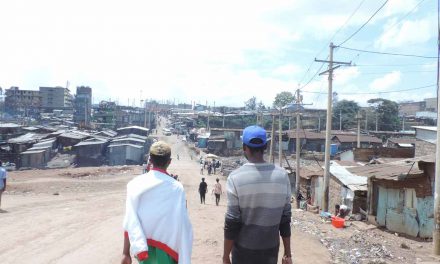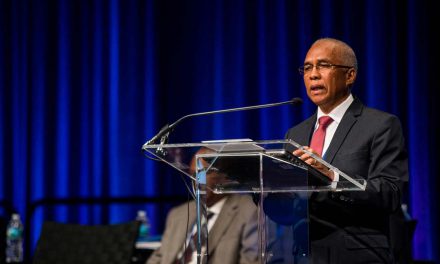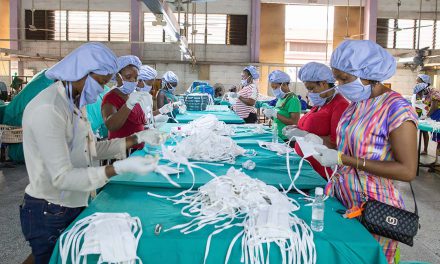African communism: a pragmatic approach
Communism was not a decisive force anywhere in Africa until the cold war made the continent a priority for the Soviet Union
A high level of industrialisation is, according to Marx and Engels, the crucial trait of societies ripe for revolution. Since they first published The Communist Manifesto in 1848, however, these authors have been repeatedly contradicted by reality. In later times, communism emerged victorious in circumstances very different from those its fathers envisioned. In fact, a communist revolution gained control of a state for the first time in Russia, a mainly rural and underdeveloped country. Other countries where it later took power were even further removed from the relations of production which Marx and Engels had predicted to be necessary for a proletarian takeover. Many of these countries were in Africa, where communism had a pivotal influence during the 20th century. As in Tsarist Russia, most parts of the continent lacked the masses of industrial workers that had been supposed to be the catalyst for the advent of a classless society.
Africa’s masses weren’t proletarians with “nothing to lose but their chains”, as Marx and Engels said of the workers they thought would want to free themselves of the capitalist yoke. Instead, communism gained prominence in Africa through state-directed action based on geopolitical interests. Until the beginning of the cold war, Africa’s exposure to Marx and Engels’ theory came through a tiny minority in countries with white European groups. “The first appearances of communist ideas in Africa were introduced by European workers in newly industrialising colonies with a significant concentration of settlers,” writes Edmond J Keller in a 2017 paper, “Communism, Marxist-Leninism, and Socialism in Africa”. In most African countries, it was of almost no consequence. In the metropoles, communism was outlawed or demonised by the authorities, who feared change at home and in the colonies.
Meanwhile, most European colonial societies were dominated by government officials, landowners and industrialists who were reluctant to consider the need for change – and who were certainly hostile to revolutionary change. Early Marxists in Africa often enlisted in the struggle secretly and at great personal cost. The four countries mentioned by Keller as having a significant communist presence were South Africa, Algeria, Egypt and the Sudan. This was particularly the case in South Africa. The British colony at the southern tip of the continent was arguably the most autonomous and dynamic colonial territory on the continent. Energised by diamond and gold rushes, its white society soon became a well-established, vibrant community with a sizeable working class employed in the mines and other industries. It was in this context that left-wing trade unions and ultimately the South African Communist Party (SACP) were born and achieved notable muscle.
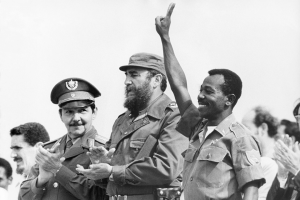
Ethiopian President Lieutenant Colonel Mengistu Haile Mariam (R) makes a V-for-victory sign as he stands with Fidel Castro (C) and Raul Castro (L) during an official visit to Havana, Cuba, in April 1975. Mengistu took power in 1977 after a coup. Photo: PRENSA LATINA / AFP
This strength did not at that stage result in the advancement of black people’s rights. The 1922 Rand Rebellion saw the party and its allied trade unions protesting a relaxation of the colour bar on the mines, a measure which would have resulted in lower salaries for white workers. Nevertheless, communism was not a decisive force anywhere in Africa until the cold war made the continent a priority for the Soviet Union in the late 1950s. Soviet leader Nikita Khrushchev wanted to win the continent in the battle for global hegemony with the US-led capitalist bloc. At the time, some African countries had just become independent or were about to, and there was a strong need for a sense of direction and economic support. So Moscow stepped in. Ghana’s Kwame Nkrumah became a Moscow protégé. He put in place socialist inspired policies and aligned his country with other international actors hostile to the West.
More importantly, Nkrumah’s potent symbolism as Africa’s first black post-colonial leader was a tremendous asset for the Soviets in their contest with the Americans for worldwide cultural influence. Not without American resistance, the Kremlin repeated this approach with other freshly-installed black nationalist presidents. Moreover, the Soviet Union began arming, training and sponsoring insurgent movements fighting western colonial dominance and the capitalist white regime in South Africa. In sub-Saharan Africa, the Soviets did not focus on the oppressed masses; rather, they wooed members of local elites who had been educated by missionaries or who had achieved so-called évolué status in French territories. It was this thin layer of the population that produced African activism for equal rights. Early forms of the struggle against discrimination and injustice around the continent were far from the revolutionary positions they would become from the 1960s.
Many liberation icons – among them Nelson Mandela and other major figures in South Africa’s African National Congress (ANC) – were professionals who came late to the socialist discourse for which they are known today. Their struggle was not against capitalism as such; rather, they wanted to end discrimination and open the door to prosperity for masses of fellow Africans who had been deprived of their rights. In their early stages, many liberation movements shared this liberal, reformist approach to change. Their leaders were, after all, aspiring bourgeoisie. In retrospect, we can ask: why did they let themselves be seduced by an ideology that rejected everything they cherished and yearned for? According to Keller, African leaders at the time made alliances with their Soviet and Chinese backers “primarily because they offered material support to the movement or dominant party in a regime, rather than being based on a clear and consistent acceptance of the guiding ideology of either the western or communist partner”.
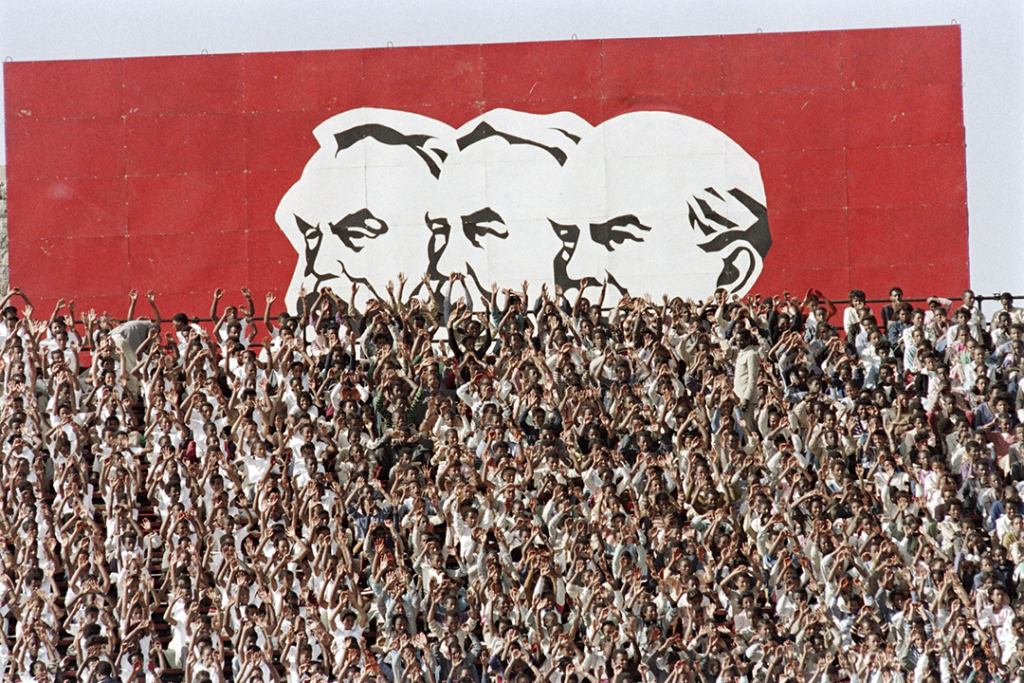
Supporters of the pro-communist Ethiopian Workers’ Party wave in front of a huge portraits of the founders of “scientific socialism” on 13 September 1987 in Addis Ababa, on the 13th anniversary of the Ethiopian revolution led by Haile Mariam Mengistu. From left: Karl Marx, Friedrich Engels and Russian Bolshevik revolutionary leader Vladimir Ilyich Lenin. Mengistu set out to create a socialist state in Ethiopia aligned with the communist bloc. Photo: ALEXANDER JOE / AFP
FRELIMO leader and future Mozambican president Samora Machel acknowledged this in the early 1970s, when he described the major communist powers as “the only ones who will really help us”, according to a 1973 report by Michael Calvert on “Counter- Insurgency in Mozambique” in the journal of the Royal United Services Institute. South Africa’s Nelson Mandela, too, alluded to what one could describe as the “minginess” of the support from liberal democracies for Africa’s quest for freedom. Shortly after his release, he gave short shrift to criticism from Miami of his visit to Cuba in 1991. Responding to attacks on his praise for a non-democratic leader, Fidel Castro, he said: “Who are they to call for the observance of human rights by Cuba? They kept quiet for 42 years when human rights were being attacked in South Africa.”
He noted that some countries had “suddenly” become keen on the ANC as its accession to power got closer. Arguably, many members of African liberation elites might have wanted to see their countries become capitalist, liberal societies. But some of the liberal democracies were former colonial powers that had denied Africans the freedoms their citizens enjoyed at home. Some communist powers, among them the Soviet Union, the German Democratic Republic and Cuba, moved in to fill the void, offering a plausible vision of full citizenship and human dignity. And, as we know, the Americans worked to counteract their influence. The Soviet and American interventions in Africa occurred mostly behind the scenes. As the cold war heated up, proxy conflicts proliferated around the continent, of which the Congo crisis in the first half of the 1960s is a relevant example.
Perhaps the only direct involvement of any communist country in Africa was the Cuban intervention in Angola, where it deployed military forces between 1975 to 1990 to keep the Marxist regime in power and repel an anti-communist military campaign of the apartheid government. Its mission in Angola only ended when Namibia became independent. The presence of Cubans in the former Portuguese colony made an indelible impression on many Africans. The solidarity of that enterprise, which was widely perceived as selfless, is still hailed in the region today. Perhaps more extraordinarily, many who lived and worked with Cuban personnel – not only in Angola, but in other African countries to which Castro sent military and civilian missions – were inspired by the Cubans’ lack of racial prejudice and the naturalness of their interaction, at least by colonial Africa’s standards.
The Angolan writer Adriano Mixingue, who studied on the Caribbean island, described the Cubans he met at home as “hardworking, friendly, fair and fun” and being “popular and well-liked”. Apart from Moscow, the other great pole of communist power in the world was Beijing. Maoist China aimed at challenging Soviet hegemony in Africa and exerted its own influence through means similar to those employed by the Kremlin. Mao Zedong’s third-world nationalism and his own experience of non-conventional guerrilla warfare made him a popular example among members of several liberation movements. Mao’s quest for relevance in Africa was especially successful in Tanzania and Zimbabwe, “two countries where different aspects of the Maoist repertoire were applied with particular vigour through the late 1960s and 1970s,” writes Julia Lovell in her book Maoism: A Global History (2019).
Replicating Maoist practices such as rural collectivisation, nationalisation and the use of violence to support a leader’s absolute authority had disastrous results in Africa, as they had in China itself – among them famine in Tanzania and “one party-thuggery and economic calamity in Zimbabwe”, the author notes. Soviet-type policies brought a comparable authoritarianism to other African countries. A marked example was that of Ethiopia under dictator Mengistu Haile Mariam. He is believed to have killed half a million people during the “red terror” campaign of 1977 and 1978. Combined with a persistent drought, Mengistu’s social engineering involved extensive nationalisation and the state seizure of all land, and it caused a famine that resulted in the deaths of hundreds of thousands in the mid 1980s. As highlighted by academic William Gumede in a 2017 article, African liberation movements were often “structured along variations of Soviet Marxist-Leninist or Chinese communist party lines with a powerful leader at the head”.
African liberation movements “were organised in a top-down, secretive and military-like fashion” that concentrated “power in the hands of either the leader or a small group”, writes Gumede. It was a pattern they maintained after assuming government. The price of having undemocratic regimes as a model is still being paid on a continent that has a deficit of democratic culture.
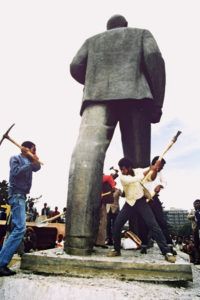
Protesters try to topple a giant “socialist realist” statue of Russian Bolshevik revolutionary leader Vladimir Ilyich Lenin on 23 May 1991 in Addis Ababa, two days after the departure of Ethiopian pro-communist strongman Mengistu Haile
Mariam into exile. Photo: JEROME DELAY / AFP


